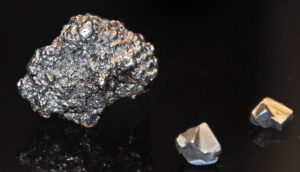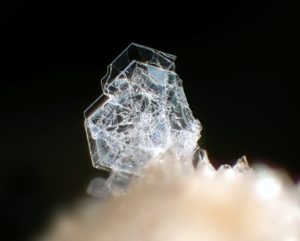 Platinum is an exotic mineral and a very expensive metal. Well-formed crystals of platinum are quite rare as platinum is usually found as a nugget or grain. Pure platinum is unknown in nature and is usually alloyed with other metals like iron, copper, nickel, gold, palladium, iridium, and others. It is a silver-white metal that is malleable and lustrous. It is very resistant to corrosion which makes it useful in both industrial applications and in fine jewelry.
Platinum is an exotic mineral and a very expensive metal. Well-formed crystals of platinum are quite rare as platinum is usually found as a nugget or grain. Pure platinum is unknown in nature and is usually alloyed with other metals like iron, copper, nickel, gold, palladium, iridium, and others. It is a silver-white metal that is malleable and lustrous. It is very resistant to corrosion which makes it useful in both industrial applications and in fine jewelry.
Where to Find the Platinum Mineral
The element platinum is incredibly scarce in most crustal rock. Concentrated areas of platinum can be found in the Earth’s crust. Platinum was first discovered in South Africa in 1906. Currently, the largest known reserves (95%) of platinum are in the Bushveld Complex in South Africa. Other areas with some platinum reserves can be found in Russia, Canada, as well as in the United States. High quantities of platinum also exist on the Moon and are also found in meteorites. Native platinum is the primary ore of platinum, but deposits containing the rare platinum arsenide, sperrylite of the pyrite group, have made a big contribution to the world’s limited supply.
History of Platinum
The earliest traces of platinum have been found in the gold used in ancient Egyptian tombs and hieroglyphics. Early Egyptian’s knowledge of the metal remains unclear, researchers believe they did not recognize the platinum in their gold.
Platinum was first referred to by Italian humanist Julius Caesar Scaliger that described it as an unknown noble metal found between Panama and Mexico in 1557. At the time, the Spanish thought of it as an impurity they often found in gold and would throw it away. From then until the 18th century, platinum would be studied by various European metallurgists and chemists, including Henrik Sheffer that published one of the first detailed scientific descriptions of the metal calling it “white gold.”
Platinum’s Value
While platinum’s reputation is that of prestige and wealth, often perceived higher than gold, the actual price of platinum is unlike gold, it is quite volatile. In 2008, the price of platinum dropped from $2,252 to $774 per ounce and it is currently less than gold at $1,099 per ounce to gold’s $1,339.





